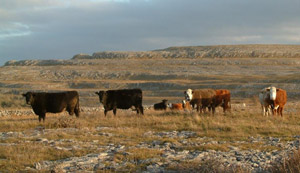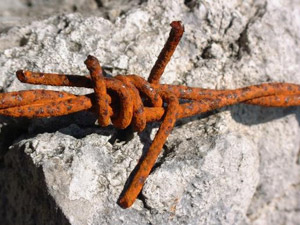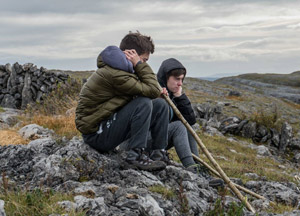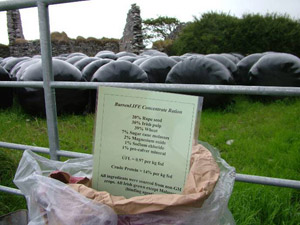The Burren, Ireland
 Burren lowlands
Turloughs
Limestone pavement
Stonewalls
Biodiverse pastures
Importance of winter grazing
Diversity of land use on farms
Aging farming population
Poor economic outlook
Abandonment and intensification
Social Infrastructure and community well being
BurrenLIFE: co-creating solutions to HNV farming challenges
The Burren Programme: a locally targeted Agri-Environmental Scheme
Farmer-centred approach to AES design and delivery
Local solutions for livestock feeding and watering systems
Burrenbeo Trust: building a conservation 'culture' and community
Farming for Conservation Awards: celebrating the HNV farmer
Local employment and adding value
Burren lowlands
Turloughs
Limestone pavement
Stonewalls
Biodiverse pastures
Importance of winter grazing
Diversity of land use on farms
Aging farming population
Poor economic outlook
Abandonment and intensification
Social Infrastructure and community well being
BurrenLIFE: co-creating solutions to HNV farming challenges
The Burren Programme: a locally targeted Agri-Environmental Scheme
Farmer-centred approach to AES design and delivery
Local solutions for livestock feeding and watering systems
Burrenbeo Trust: building a conservation 'culture' and community
Farming for Conservation Awards: celebrating the HNV farmer
Local employment and adding value

Low-lying limestone plain with thin layers of fertile soil, outcroppings of limestone pavement, and an extensive system of calcareous lakes and fens of high conservation importance. Winter grazing is less frequent compared to in the highlands.

Turloughs are temporary lakes that occur in limestone depressions and a distinctive wetland feature of karstic limestone areas of western Ireland. They are traditionally important summer pastures and provide a calcium rich water supply. The Burren lowlands contain the most extensive area of naturally functioning turloughs in Europe.

Common throughout the Burren, Ireland has the largest area of limestone pavement in the EU. The limestone bedrock acts as “underfloor heating”, creating conditions for the unique “winterage” pasturing practice, where grazing animals are taken to the highlands for the winter. This practice supports unique flora communities.

Stonewalls are the dominant field boundary in the Burren, and some of the walls are thought to be over 4,000 years old. They form boundaries and shelters and are part of extensive field systems of great archeological importance. Many stonewalls have fallen into disrepair.

The HNV farming systems have produced one of the most biodiverse pasture areas in western Europe. Relatively common species such as Geranium sanguineum flourish alongside 23 of Ireland’s 27 orchid species and regional specialities such as the Alpine Gentiana verna, the Arctic Dryas octopetala and the Mediterranean Neotinea maculata whose main British and Irish populations occur in the Burren.

A unique agrarian practice known as ‘winterage’ occurs in the Burren. Winterage is a form of ‘reverse transhumance’ whereby cattle are put up on the rough grazing of the Burren uplands in October. They remain there until the following Spring at which point they are brought back down to the more fertile/improved lowland pastures.

Burren farms have a complex habitat make up. As well as winterages, most Burren farms also contain areas of ‘improved’ land. The proportion of improved land to semi-natural pasture (summer land to winter land) varies from farm to farm and is a key determinant of how that farm is managed. The improved summer land allows stock to regain condition while winterages are rested during the flowering season.

Fewer young farmers are entering farming, and knowledge of HNV farming practices is being lost. Farmers are finding it increasingly difficult to source local labour to carry out required HNV conservation actions such as scrub removal.

Farming remains an unviable occupation for most farmers, even with additional funding provided by the Burren Programme. Farmers currently gain very little from tourism or added value gained from livestock sales, and many rely on off-farm work.

Notwithstanding the impact of the Burren programme, scrub continues to encroach onto the Burren’s grasslands while on lowland areas there is continued, often damaging, intensification (reclamation, nutrient input) activities.

Social infrastructure and community wellbeing initiatives are required to combat rural isolation and improve attractiveness of farming as a career choice for the next generation. Improved marketing, product development and diversification opportunities are needed to realise a vision of sustainable HNV farming in the Burren.

Relationships between farmers and conservation authorities were at an all-time low after introduction of Habitats Directive and ill-fitting National Agri-environment schemes. Diverse stakeholders came together under EU LIFE Nature funding (2004-2009) to co-create management interventions for sustainable agricultural management of the Burren.
BurrenLIFE: co-creating solutions to HNV farming and conservation challenges

Department of Agriculture provided funding to roll out BurrenLIFE Project’s ‘blueprint’ for sustainable farming across 15,000ha of the Burren through a locally targeted ‘hybrid’ agri-environment scheme whereby farmers are paid for project actions and also for project impact/results on HNV farmland.
The Burren Programme: a locally targeted ‘Hybrid’ Agri-Environmental Scheme (AES)

A farmer-centred approach was adopted for every aspect of the Burren Project. Payment structures were designed to be very clear and transparent – for example, every payment is linked to a specific action or a specific field score. Paperwork was simplified, more freedom to farm was allowed and annual training was organised.
Adopting a farmer-centred approach to AES design and delivery

The two biggest challenges to the Burren’s HNV farmland are undergrazing, leading to scrub encroachment, and silage feeding, leading to pollution and species loss. A solution was identified: replacing silage feeding with concentrate feedstuffs which could, in turn, increase forage uptake by livestock - a double dividend.
Developing locally tailored livestock feeding and watering systems

Burrenbeo - ‘the living Burren’ - is a local charity which affirms that the Burren is a ‘living landscape’ and not a heritage museum. Over 2,000 children have graduated as 'local experts' in the Burren through completion of Burrenbeo’s 10-module 'Eco-Beo' programme in local schools.
Burrenbeo Trust: building a conservation 'culture' and community in the HNV Landscape

The annual 'Farmer for Conservation Awards' has five categories: ‘Best HNV pasture’, ‘Best HNV meadow’, ‘Highest standard of HNV works’, ‘Farm family of the Year’ and ‘Farmer of the Year’. The latter is based on environmental performance scores, work completed and additional effort.
Farming for Conservation Awards: celebrating the HNV farmer

Additional innovations creating local employment included forming a Workers Database - listing 80 local farmers available to undertake part-time conservation work on other farms. The ‘Traditional Burren gate’ now made by three local companies for supply to local farmers, and some farmers are now providing farmhouse lunches and farmer-led walks for study groups as part of Burrenbeo’s learning landscape initiative.
Adding value to HNV farming
The Burren, located on Ireland’s mid-western coast, covers 72 000 ha. The name derives from the Gaelic work ‘Boireann’, meaning ‘Place of Stone’. It is the most extensive glaciated karst landscape in Western Europe. The Burren extends from sea level to over 300m and encompasses the Gort lowlands. Extensive livestock grazing systems occur on farms composed of mosaics of improved lands, semi-natural grasslands and heaths, limestone pavement, scrub and woodlands. A unique outwintering farming system has developed with the limestone bedrock offering a ‘dry lie’ for outwintering cattle. The heritage value of the Burren is recognised numerous awards including European Diploma for Protected Areas and UNESCO Geopark Status. For more information on the area, see the Baseline Assessment.
Innovations in The Burren:
- BurrenLIFE: co-creating solutions to HNV farming and conservation challenges
- The Burren Programme: a locally targeted ‘Hybrid’ Agri-Environmental Scheme (AES)
- Adopting a farmer-centred approach to AES design and delivery
- Developing locally tailored livestock feeding and watering systems
- Burrenbeo Trust: building a conservation 'culture' and community in the HNV Landscape
- Farming for Conservation Awards: celebrating the HNV farmer
- Adding value to HNV farming
Some useful links:
Innovations relevant for The Burren from other project areas:
- Bulgaria - Farmers association Food from the mountain
- Bulgaria - Linbul farm (grass-fed beef online sales)
- France - Collective approaches by breeders
- Greece - 3D-mapping tools and GPS-tracking system
- Greece - Participatory guarantee system
- Sweden - Mobile abattoir
- The UK - Dartmoor Vision
- The UK - Dartmoor Farming Futures
Other Downloads:
- Baseline Assessment
- All innovation work in the LA
- Report from the Innovation seminar
- Innovation report
(July 2018)

